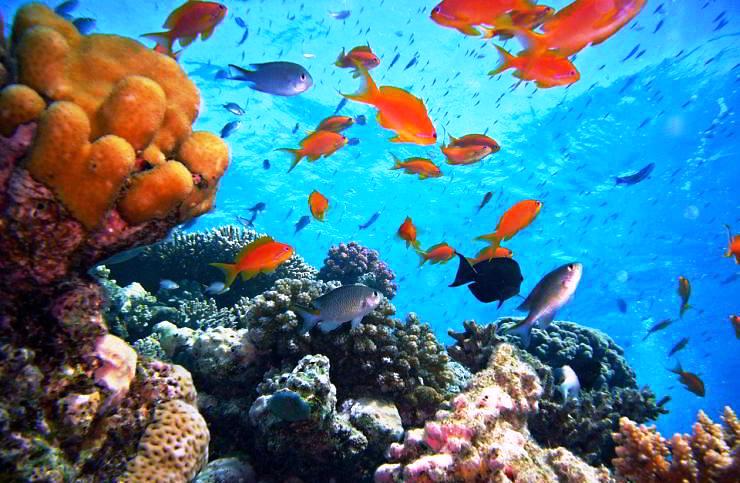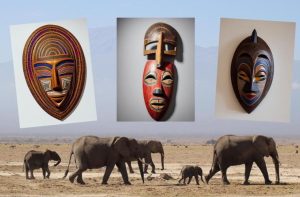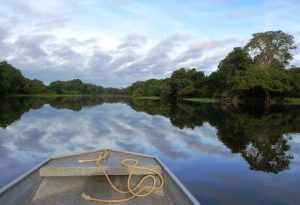Between Mozambique and Madagascar lies an extraordinary stretch of the Indian Ocean: the Mozambique Channel. This stretch of water is a unique ecosystem where marine life manifests itself in all its incredible variety and beauty.
In the Indian Ocean, between the eastern coast of Mozambique and the western coast of Madagascar, lies one of the most extraordinary underwater paradises on the planet: the Mozambique Channel. This strip, varying in width from 450 to 950 kilometres, is approximately 1,600 kilometres long and up to 4,000 metres deep, and is home to one of the richest and most diverse marine ecosystems in the world.
The Mozambique Channel is much more than a simple sea passage: it is a true cradle of biodiversity, where warm currents from the north meet colder ones from the south. This phenomenon creates an ideal environment for the proliferation of marine life, which develops in an extraordinary variety of habitats: coral reefs, submerged cliffs, caves and marine forests.
Each dive reveals scenarios that seem to belong to another planet: gardens of colourful coral, underwater cavities inhabited by mysterious creatures and meadows of algae that sway gently following the rhythm of the currents.
This environmental diversity supports a complex ecological network in which each species plays a fundamental role in maintaining the balance of the ecosystem. However, the Mozambique Channel is also a fragile ecosystem, threatened by rising sea temperatures, intensive fishing and pollution. All that remains is to dive in to discover its precious and fragile submerged treasure.
The waters of the Mozambique Channel are populated by extraordinary marine fauna, which alternate majestic and imposing creatures with small treasures hidden among the coral formations. It is impossible not to be fascinated by an encounter with a whale shark (Rhincodon typus), the gentle giant of the sea, which can exceed 12 meters in length.
Despite its imposing size, this colossus feeds exclusively on tiny particles of plankton, filtering them from the water through its enormous mouth. The warm and nutrient-rich waters of the Channel attract hundreds of whale sharks, offering divers an unforgettable spectacle. Spotting one during the migration season, from October to March, is an unforgettable experience that leaves one breathless.
No less spectacular are the giant manta rays (Manta birostris Walbaum), which seem to fly underwater with their sinuous wings, offering a show of grace and elegance. With wingspans that can exceed seven meters, manta rays gather near coral reefs, often near Nosy Be (Madagascar) or the Bazaruto archipelago (Mozambique), but also off the island of Mayotte (Comoros), to be cleaned by small fish that remove parasites and debris from their skins.
The meadows of flowering sea plants are also home to one of the rarest and most fascinating inhabitants of the channel, the dugong (Dugong dugon), a relative of the manatee. This placid-looking mammal spends its days feeding on seaweed, moving slowly in the shallow waters near the Mozambican coast, particularly in the Bazaruto Archipelago Park, where, however, its presence is becoming increasingly rare.
Among the most enigmatic creatures of the Mozambique Channel is a prehistoric fish that survives between the Comoros and Madagascar, the coelacanth (Latimeria chalumnae), which was thought to be extinct for millions of years until its rediscovery in 1938. This “living fossil”, the subject of scientific studies, can reach two meters in length and lives at depths between 150 and 700 meters. Its biology is unique: it has lobed fins that resemble primitive limbs, a feature that makes it a symbol of the evolution between fish and terrestrial vertebrates.
While the giants of the sea may dominate the depths, it is in the submerged gardens of coral reefs that some of the most fascinating secrets of this ecosystem are hidden. The reefs of the Mozambique Channel are a riot of colour and life, teeming with tropical fish with bright liveries. Among the most fascinating is the lionfish, with its fan-shaped fins and red and white striped body.
Despite its beauty, it is a dangerous creature: its spines are poisonous and represent a threat to anyone who gets too close. The “emperor angelfish” also moves gracefully in these clear waters, recognisable by the blue and yellow stripes that streak its body. This elegant reef dweller feeds on sponges and small invertebrates, helping to maintain the balance of the fragile ecosystem.
The small, brightly coloured Mozambique clownfish (Amphiprion latifasciatus) is also closely associated with the coral reefs of the Channel, where it lives in symbiosis with sea anemones. The relationship is mutually beneficial: the anemone protects the fish from predators with its stinging tentacles, while the clownfish cleans the anemone and protects it from possible parasites. Interestingly, all clownfish are born male, but some can change sex if necessary to maintain the balance of the group.
Among the most fascinating molluscs that populate the Mozambique Channel, the mimetic octopus (Thaumoctopus mimicus) is known for its extraordinary ability to imitate other marine species, such as sea snakes, rays and even poisonous jellyfish. This mollusc uses camouflage not only to escape predators but also to approach prey without being noticed. Its intelligence and ability to adapt make it one of the animals most studied by scientists.
Hidden among the rocks and corals, one can also encounter spiny lobsters, which, with their long antennae, incessantly explore the surrounding environment. In the same habitat, one can encounter the mantis shrimp (Odontodactylus scyllarus), also called “peacock shrimp” for its bright colours: a predatory crustacean equipped with powerful claws that it can use to break mollusc shells or even break aquarium glass. Its claws move at incredibly fast, creating shock waves that can stun its prey.
In addition to its strength, the mantis shrimp has exceptional vision: its compound eyes are among the most complex in the animal kingdom and allow it to see ultraviolet light and polarisation.
No less exciting is the encounter with a hawksbill turtle (Eretmochelys imbricata) that nests on the beaches of Mozambique. Its main diet consists of sea sponges, which often contain toxins that are lethal to other predators. However, the hawksbill turtle can digest them safely, accumulating the toxins in its body. The illegal collection of its shell, used for the production of decorative objects, represents a serious threat to its survival.
One of the most important species from an economic and food point of view, the yellowfin tuna (Thunnus albacares) is a pelagic fish that travels the waters of the Mozambique Channel in large schools. It can reach two meters in length and weigh over 200 kilos. Although they are a delicacy highly sought after by fishermen, observing one of these creatures in its natural habitat is an experience that enriches every dive. But the wonders of the Mozambique Channel do not stop at the fauna.
On the seabed, there are veritable underwater forests of brown algae that sway gracefully with the currents. These marine plants play a fundamental role in the oxygen cycle, as well as offering refuge to a multitude of fish species, which find protection among their submerged branches.
Deeper, beyond 200 metres, black corals lie hidden, a rarity in these waters. They grow slowly and form intricate structures that offer refuge to deep-sea fish and other marine creatures. Their presence is an indicator of the good health of the ecosystem, but they are also extremely fragile and vulnerable to environmental changes.
At the bottom of the Channel, the sands hide another kind of treasure: precious minerals such as titanium, zirconium and rutile. And immense deposits of methane gas, such as those discovered off the coast of northern Mozambique. These elements represent an important resource but also a potential threat, since mining and hydrocarbon extraction can put the ecological balance of the region at risk.
Furthermore, climate change, pollution and overfishing are already threatening this fragile ecosystem. Protecting the Mozambique Channel means preserving not only one of Africa’s most extraordinary natural wonders but also ensuring that future generations can continue to explore and marvel at this submerged treasure. (Francisco Machava/Africa) – (Photo: Pixabay)









